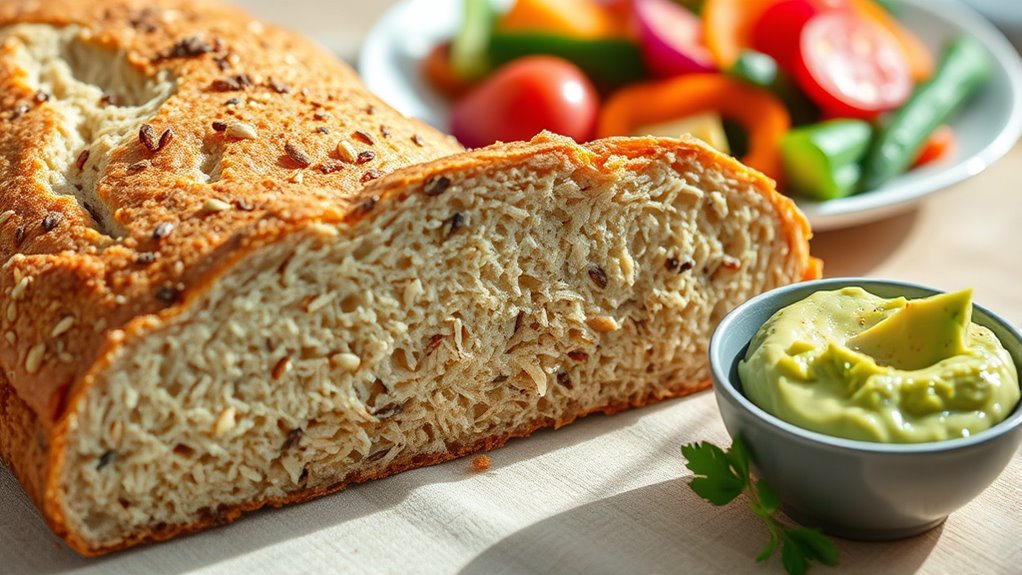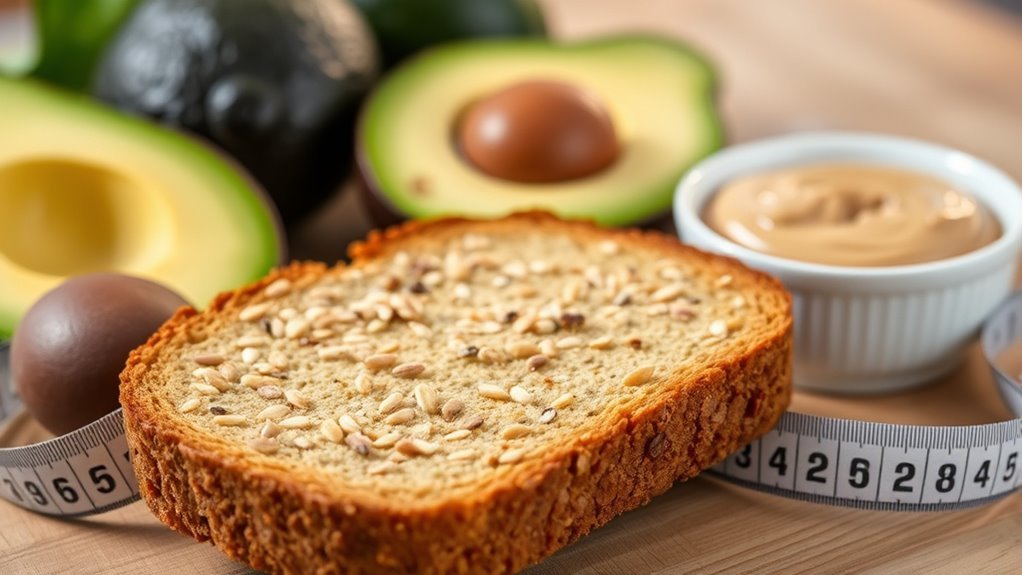Keto bread can be a good option for managing diabetes due to its low carbohydrate content and high fiber profile, which helps regulate blood sugar levels. The ingredients, like almond flour and psyllium husk, support digestive health while keeping insulin sensitivity in check. However, moderation is key, as excessive consumption might lead to nutritional imbalances. You might want to explore more about how to incorporate keto bread effectively into your diet for maximum health benefits.
Understanding the Ketogenic Diet and Its Impact on Diabetes

The ketogenic diet, often referred to as keto, has gained significant attention for its potential benefits in managing diabetes. By focusing on ketogenic principles—high fats, moderate proteins, and very low carbohydrates—you may find improved blood sugar control. This diet encourages your body to enter a state of ketosis, where it burns fat for fuel instead of glucose. Diabetes awareness is important, as maintaining stable blood sugar levels is fundamental for overall health. Studies suggest that a keto approach can lead to reductions in insulin resistance, making it an appealing option for some individuals managing diabetes. However, it’s essential to consult with healthcare professionals to tailor the diet to your specific needs and guarantee it’s safe for your situation.
Nutritional Profile of Keto Bread

When considering keto bread, you’ll find that its low carb content is one of its most appealing features, especially for those managing diabetes. Additionally, many recipes incorporate fiber-rich ingredients, which can support digestive health. It’s also important to note that keto bread can provide essential nutrients, helping to maintain a balanced diet while following a ketogenic lifestyle.
Low Carb Content
Although many bread options are high in carbohydrates, keto bread stands out with its markedly lower carb content, making it a favorable choice for those managing diabetes. By opting for keto bread, you’re likely to experience several low carb benefits, including:
- Stabilized blood sugar: With fewer carbs, your blood sugar levels can remain more consistent throughout the day.
- Reduced cravings: Lower carbohydrate intake may help curb those pesky hunger pangs, keeping you satisfied longer.
- Weight management: A lower carb diet often supports weight loss, which can improve overall health and diabetes management.
Keto bread provides a delicious alternative without the carb overload, allowing you to enjoy your meals while prioritizing your health.
Fiber and Nutrients
While many traditional bread options lack essential nutrients, keto bread can be a surprisingly nutrient-dense choice. Packed with healthy ingredients, it often includes fiber sources like almond flour or coconut flour, which can aid digestion and help regulate blood sugar levels. These ingredients not only provide lower carb counts but also contribute to a richer nutrient profile. Keto bread typically contains healthy fats, vitamins, and minerals, making it a more balanced option. By choosing keto bread, you can enjoy the freedom of indulging in bread without sacrificing nutritional value. Just keep in mind that not all keto breads are created equal, so it’s wise to check labels and choose those with higher nutrient density for the best health benefits.
Key Ingredients in Keto Bread

Keto bread is a popular alternative for those looking to maintain a low-carb lifestyle, especially individuals managing diabetes. The key ingredients in keto bread not only promote a lower carbohydrate intake but also provide essential nutrients. Here are three vital components:
Keto bread offers a delicious low-carb option for those managing diabetes while ensuring essential nutrients are included.
- Almond Flour: This nut-based flour is low in carbs and high in healthy fats, making it a great option for keto diets.
- Psyllium Husk: Known for its high fiber content, psyllium husk helps to create a bread-like texture and supports digestive health.
- Eggs: They act as a binding agent and add protein, which is essential for satiety.
Incorporating these ingredients can help you enjoy delicious bread while staying aligned with your dietary goals.
Glycemic Index and Blood Sugar Response
Understanding the glycemic index (GI) is essential for managing blood sugar levels, especially if you have diabetes. Foods with a low GI, like many keto breads, can help regulate your blood sugar response more effectively than high-GI options. By incorporating low-GI choices into your diet, you can better support your overall diabetes management.
Glycemic Index Overview
The glycemic index (GI) serves as a valuable tool for understanding how different foods affect your blood sugar levels. It measures the glycemic response of foods, indicating how quickly they raise blood sugar after consumption. Foods with a high GI can lead to rapid spikes, while low GI options promote steadier levels.
Consider these factors:
- Carbohydrate Absorption: Foods that digest quickly raise blood sugar faster, impacting your energy levels.
- Food Choices: Selecting low-GI foods can enhance your overall health and help maintain stable blood sugar.
- Personalization: Everyone’s body reacts differently, so it’s essential to monitor your response to various foods.
Blood Sugar Regulation
When you eat, your body processes carbohydrates into glucose, which directly influences your blood sugar levels. Foods with a high glycemic index can cause rapid spikes in blood sugar, which may lead to increased insulin resistance over time. On the other hand, keto bread typically has a lower glycemic index, promoting better insulin sensitivity. This means that it can help you maintain more stable blood sugar levels. By choosing keto bread, you might find yourself enjoying the freedom to indulge in bread-like options without the guilt of high blood sugar spikes. Additionally, maintaining stable blood sugar can contribute to overall health, as it reduces the risk of complications associated with diabetes. Always consider how your food choices impact your body.
Impact on Diabetes Management
While many people with diabetes struggle to find suitable bread options, keto bread offers a viable alternative due to its lower glycemic index. This can help you manage your blood sugar levels more effectively. Here’s how keto bread can be diabetes friendly:
- Lower Carbohydrate Content: Keto bread usually contains fewer carbs, reducing the likelihood of blood sugar spikes.
- High Fiber: Many keto breads are made with almond flour or coconut flour, which are rich in fiber, aiding digestion and blood sugar control.
- Protein-Rich Ingredients: The inclusion of eggs or protein powders can help stabilize blood sugar by slowing down carbohydrate absorption.
Embracing keto bread can provide you with more freedom in your diet while still supporting effective diabetes management.
Potential Benefits of Keto Bread for Diabetics
Keto bread can offer several potential benefits for those managing diabetes. First, its low carbohydrate content helps stabilize blood sugar levels, reducing the risk of spikes that can occur with traditional bread. This can lead to improved overall glucose control, which is essential for diabetes management. Additionally, keto bread is often high in fiber, promoting better digestion and increased satiety, helping you feel full longer. This can assist in weight management, another important aspect of diabetes control. Furthermore, many keto bread recipes include healthy fats, which can enhance heart health. By incorporating keto bread into your diet, you might find it easier to enjoy your meals without compromising your health, making it a satisfying option for those seeking diabetes benefits.
Possible Drawbacks and Considerations
Although keto bread can be a beneficial option for managing diabetes, there are some potential drawbacks and considerations to keep in mind. Here are three key points you should consider:
- Health Risks: Some keto breads may contain additives or unhealthy fats that could impact your overall health. Always check ingredient labels.
- Portion Control: It’s easy to overindulge, thinking keto bread is a free pass. Stick to recommended serving sizes to avoid spikes in your blood sugar.
- Nutritional Balance: While low in carbs, keto bread might lack essential vitamins and minerals. Pair it with nutrient-dense foods to maintain a well-rounded diet.
Being mindful of these factors can help you make informed choices while enjoying keto bread in moderation.
Frequently Asked Questions
Can I Make Keto Bread at Home?
Yes, you can definitely make keto bread at home! There are plenty of keto bread recipes available that use low-carb ingredients like almond flour, coconut flour, or flaxseed meal. These homemade alternatives can be delicious and nutritious, allowing you to control the ingredients. Plus, they’re often quick to whip up, giving you the freedom to enjoy fresh bread without the carbs. Just search for recipes that suit your taste and dietary needs!
How Does Keto Bread Compare to Traditional Bread?
How can you resist the appeal of low carb benefits? Keto bread typically has fewer carbs than traditional bread, making it a better option for those watching their carb intake. It often incorporates ingredients like almond flour or coconut flour, which can boost fiber content, aiding digestion. While it may not replicate the exact texture or taste of regular bread, it offers a satisfying alternative that aligns with a low-carb lifestyle, giving you more freedom in your choices.
Is Keto Bread Suitable for a Gluten-Free Diet?
Keto bread can be suitable for a gluten-free diet, but it depends on the ingredients. Many keto recipes use gluten substitutes like almond flour or coconut flour, which are low carb options that also cater to gluten sensitivity. However, always check labels if you’re buying pre-made keto bread, as some may contain gluten. If you’re baking at home, you can control the ingredients to guarantee it meets your dietary needs.
How Often Can Diabetics Consume Keto Bread?
How often can you enjoy keto bread if you’re managing diabetes? It really comes down to portion control and meal timing. You can include it in your diet a few times a week, but keep an eye on your overall carb intake. Balancing your meals and monitoring your blood sugar levels is essential. By being mindful, you can have that freedom to enjoy keto bread without compromising your health!
Are There Specific Brands of Keto Bread Recommended for Diabetics?
Yes, there are several keto bread brands that offer diabetes-friendly options. Look for brands like ThinSlim Foods and Franz Keto Bread, which are low in carbs and high in fiber. These breads can help you manage your blood sugar levels while still enjoying your meals. Always check the nutrition labels to verify they fit your dietary needs, and consider consulting with your healthcare provider to make the best choices for your lifestyle.


